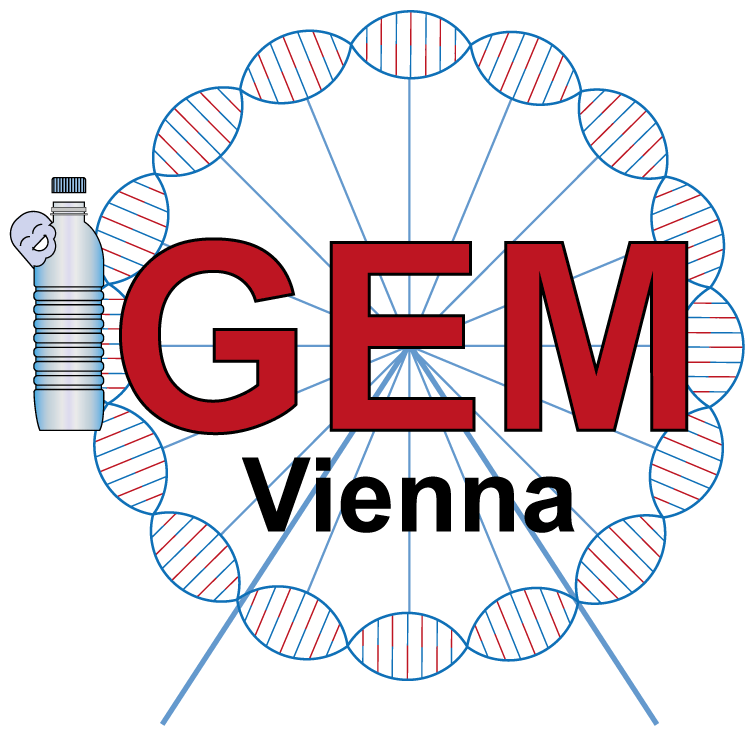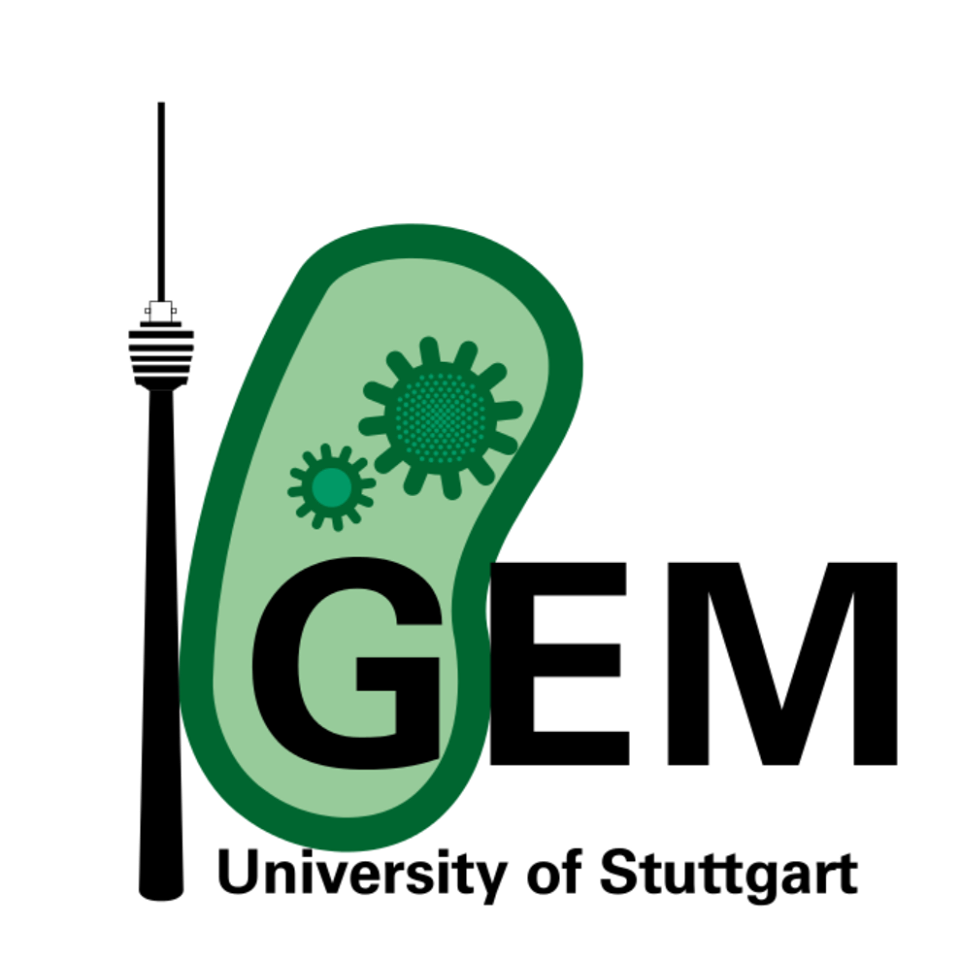| Line 221: | Line 221: | ||
{{#tag:html|<div id="collaboration4"></div>}} | {{#tag:html|<div id="collaboration4"></div>}} | ||
{{Heidelberg/templateus/coloredHeading|green|iGEM goes green}} | {{Heidelberg/templateus/coloredHeading|green|iGEM goes green}} | ||
| − | |||
| − | |||
| − | |||
| − | |||
| − | |||
{{#tag:html| | {{#tag:html| | ||
Revision as of 14:08, 1 November 2017
Collaborations
Mutagenesis Plasmid Inter-Lab Study




Mutagenesis Assay Kit
We shipped 3 mutagenesis plasmids (#1-3). All mutagenesis inducing plasmids contain an arabinose inducible promoter PBAD. Upstream of PBAD the araC protein is encoded in the opposite direction and regulates the activity of the PBAD promoter. The expression cassette downstream PBAD comprises multiple, different mutagenesis supporting elements, e.g. error-prone polymerase subunits. According to literature
Mutagenesis Assay – Spontaneous Resistance Acquisition
Due to exceptionally high mutagenesis levels of E. coli cells transformed with one of the mutagenesis plasmids, these cells can more quickly adopt to environmental changes. Hence, one way to measure the mutagenesis levels is simply to quantify the level of spontaneous antibiotic resistance acquisition. Therefore, E. coli were transformed with mutagenesis plasmids or remain untransformed (as control) followed by incubation in presence or absence of different antibiotics on agar plates. After 18-21 hours of incubation at 37 °C, colonies are counted. A higher number of colonies (i.e. clones with spontaneous resistance acquired) thereby indicates a higher mutation rate in the corresponding E. coli population due to the presence of the mutagenesis plasmid.
Results from the Study
To decide which mutagenesis plasmid to recommend to future iGEM teams for in vivo directed evolution approaches such as PREDCEL, it was essential to determine the mutagenesis plasmid setup most robustly functioning across different laboratories. The results of iGEM team BOKU Vienna, ETH Zürich, Freiburg and Stuttgart indicate that MP #1 induces mutations most reliably . Hence, we recommend to use mutagenesis plasmid #1 for PREDCEL experiments, which is also noted in our corresponding RFC. The results are shown and described on our MP InterLab page
Cloning a Positive Control for Freiburg
Collaborating with the iGEM Team Freiburg we cloned a positive control for a subproject of their CARTEL™ project.Under normoxic conditions HIF1A cannot interact with HIF1B to form the transcription factor HIF1, because its hydroxylated and marked by the E3 ubiquitin ligase for degradation by the proteasome
Because we wanted to collaborate with this year’s iGEM Team Freiburg , we offered to help them with our Golden Gate cloning expertise to perform a site directed mutagenesis and generate the constitutively active HIF1A. It would be used Freiburg as a positive control for CoCl2 induction in analysis of HRE.
For the aforementioned two amino acid exchanges alanine to proline we decided to utilize PCR amplification followed by Golden Gate cloning for site directed mutagenesis. To insert the two point mutations three steps were performed. We divided the ~7.9 kb plasmid into three fragments by (i) PCR amplification. The primes were designed with Golden Gate overhangs and BsmBI restriction sites.
Table 1: Primer sequences for site directed mutagenesis in HIF1-alpha
| Primer position | Position 402 | Position 564 |
|---|---|---|
| forward | TTCGTCTCAGCAGCCGCTGGAGACACAATCATATCTTTAGATTTTG | TTCGTCTCAGCCTATATCCCAATGGATGATGACTTCCAGTTACGTTC |
| reverse | TTCGTCTCACTGCGGCCAGCAAAGTTAAAGCATCAGGTTCCTTC | TTCGTCTCAAGGCAGCTAACATCTCCAAGTCTAAATCTGTGTCCTGAGTAG |
Table 2: Primers for backbone splitting
| Primer position | Ampicillin resistance |
|---|---|
| forward | TTCGTCTCAATCTTCAGCATCTTTTACTTTCACCAGCGTTTCTG |
| reverse | TTCGTCTCAAGATCAGTTGGGTGCACGAGTGGGTTAC |
PCR First Aid Service
As we had several PCR problems ourselves in the beginning of our project, we asked our advisors for help and created a PCR troubleshooting protocol, which you can find on our protocol section. Because we considered it to be helpful for other teams as well, we decided to offer help for all other iGEM teams: our First Aid Service for PCR Problems. Happily we could help some teams overcoming their PCR problem.Helping iGEM Hamburg with their PCR problems
Since the beginning of their project the iGEM team Hamburg experienced difficulties performing gene amplifications. After tedious trial and error using different gradient-PCRs, experimenting with GC-enhancer solutions and DMSO concentrations we figured out a way to amplify eleven out of their twelve genes and gene fragments. The only one that did not work despite their efforts was the AraC family transcriptional regulator. They noticed our PCR First Aid Service and after a skype call in which Hamburg described their problems and attempts we gave them valuable tips. Our ideas were a raise of the annealing temperature to 72 °C, adding 0.5 M betaine, try adding DMSO in 3 %, 5 % or even 10 % concentration or a combination of both DMSO and betaine. Hamburg gave a try to all these suggestions, unfortunately without having a hit. We discussed the result with the iGEM Team Hamburg becuase we did not want to give up an gave additional tips to try. Our next suggestion was to design new primes, as ours had a very high GC content in the middle part and were therefore prone to the formation of secondary structures. Also, the new primer pairs should be designed to anneal at 72 °C. They offered to design to take over the design for us. These were the original primers: Fw: CATTATGAATTCGCGGCCGCTTCTAGA Rv: GATAATCTGCAGCGGCCGCTACTAGTA
Table 3: Original primers designed by Hamburg
| Orientation | Sequence |
|---|---|
| forward | CATTATGAATTCGCGGCCGCTTCTAGA |
| reverse | GATAATCTGCAGCGGCCGCTACTAGTA |
Table 4: Improved primer sequences designed by Heidelberg
| Orientation | Sequence |
|---|---|
| forward | CATTATGAATTCGCGGCCGCTTCTAGATGACCATCACCATC |
| reverse | GATAATCTGCAGCGGCCGCTACTAGTATTAG |
iGEM goes green

Mentoring Stuttgart
Adviceoptogenetic Killswitch
Translation Center
Bringing science closer to the public is a major goal in iGEM. As communicating scientific content can be challenging because complex issues need to be unraveled to easy understandable terms, one step could be translating scientific texts into many languages. Following this idea, the iGEM Team KU Leuven started a translation center and asked all teams to participate. Each team uploaded its project description and translated other project descriptions into their mother tongue. This is a first step towards simplification and easier communication with the general public because one barrier, namely the language barrier, can be overcome with the translation center. We translated several project descriptions into German and could thereby hopefully contribute to a better communication between scientists and a broad public.https://static.igem.org/mediawiki/2017/7/79/Collaboration_Medal.png
Postcards
Participating in the Postcard campaign of Duesseldorf-Cologne was a real success. Thanks to the inspiring and eye-catching designs of all postcards we started talks about synthetic biology, GMOs and other issues addressed by over 36 postcards we received.https://static.igem.org/mediawiki/2017/d/d3/T--Heidelberg--HP_collaborations_postcards.jpeg
No Science without Tolerance
Respect is an essential iGEM value and tolerance an important aspect of it. We were thus very happy to support the tolerance campaign by iGEM Team Technion (Israel). All our creativity was used to draw this lab-associated tolerance lettering and we can hopefully contribute to draw more attention to the fundamental value of tolerance in the scientific community and in public.PICS
https://static.igem.org/mediawiki/2017/a/ac/T--Heidelberg--HP_Collab_Tolerance-Lettering.jpeg
https://static.igem.org/mediawiki/2017/2/24/T--Heidelberg--HP_Collab_Tolerance-Team.jpeg
Surveys – Supporting Responsible and Efficient Technology Development within iGEM
Bostons Microfluidic SurveyThe Boston University Hardware team worked with microfluidic chips and wanted to establish an archive with different designs and protocols. Their goal is to fit the archival structure to any needs of its users. To support this project, we filled in their survey and could thereby hopefully contribute to a well applied, sustainable design of their archive.
Beijing Institute of Technology: Survey according health care and liver cancer
iGEM Team BIT worked on a liver cancer related project and wanted to integrate the opinion of us iGEMers into the design of their project. We answered their survey and are looking forward to seeing their great ideas realized.
Biological Material Transport Survey from State University of Amazonas
Shipment of biological material often faces problems when cooling is required and long distances need to be conquered. This is particularly true for less developed countries and regions with no direct access to an (freight) airport. The Amazonas Brazil team wanted to collect information from all over the world to get a deeper insight into import and export regulation processes of countries around the world. We hope that we supported your collection of information by thoroughly answering your questionnaire.
Air pollution survey from iGEM Pasteur Paris
Environmental pollution and climate change are two of the major challenges we desperately need to solve towards our agreed goal of a sustainable human civilization on our planet. The iGEM Team Pasteur Paris focused on environmental issues and highlighted the problem of air pollution, which is particularly strong problem in quickly industrialized countries with low standards of waste air cleaning in fossil fuel power stations, industrial facilities and transportation vehicles. To receive an impression about the air pollution situation in different regions all over the world they created a comprehensive survey. We hope that we could convey an impression about the situation in Heidelberg, which fortunately is a rather small, bicycle-friendly city closely surrounded by five beautiful nature reserves. iGEM Team Heidelberg is also taking part in the iGEM goes green initiative by team TU Dresden.
Survey about methane production from UNebraska-Lincoln
The iGEM Team UNebraska-Lincoln aims at inhibiting the methane production in cattle and wanted to integrate the general public opinion into the design of their project. All members of iGEM team Heidelberg filled in their survey and we are looking forward to helping you gather information and maybe even contribute to decreasing the alarming speed of climate change.
Survey about cholera from iGEM Toulouse
In order to tackle the cholera disease, the iGEM Team Toulouse asked everyone to answering their questionnaire to receive an impression about the informational situation according to cholera disease. Hopefully we could contribute a little bit to succeeding with your project on eradicating Vibrio cholerae.
Genetic modification to produce medicines - Cardiff iGEM
To investigate the public´s view on genetic modification for pharmaceutical production the Cardiff iGEM Team created a survey. They aim at treating the Grave´s Disease, an autoimmune disease affecting the thyroid, with the help of genetically modified organisms. We filled in their questionnaire and hope that they succeed with realizing their innovative therapeutic approach.
GMO perception survey from Ionis Paris
To gain more information about GMO perception by the public the iGEM Team Ionis Paris conducted a survey we took part in. They aim at creating an interactive map to make the comprehensive information from their interesting questionnaire easily accessible. This map contains regimentations and opinions about GMOs and could provide novel insights into region-specific, public perception on the creation and use of GMOs.
CRISPR along the iGEM: survey from Amazonas Brazil
No doubt that CRISPR is a breakthrough technology that should be easily accessible by any (responsible) researcher around the globe. To establish a simple and standardized methodology for applying CRISPR the iGEM Team Amazonas Brazil created a survey to communicate with other iGEM teams and exchange information about problems when working with the CRISPR technology. We participated in this survey and are eager to see your solutions for an easier handling of this method come into play in iGEM.
Diagnosis device survey from iGEM Team Munich
The iGEM Team Munich collected opinions about diagnostic devices in a survey that was distributed to people with different professional backgrounds. In certain countries access to regular medical care is limited, either due to regional fluctuation in the density of hospitals, pharmacies and doctors or due to country-specific healthcare laws. This issue affects millions of people world-wide, both in developing as well as modern countries. iGEM Team Munich aims at developing diagnostic devices, that could be used at home and provide people with diagnosis and hence medical care that would otherwise have no access to.

